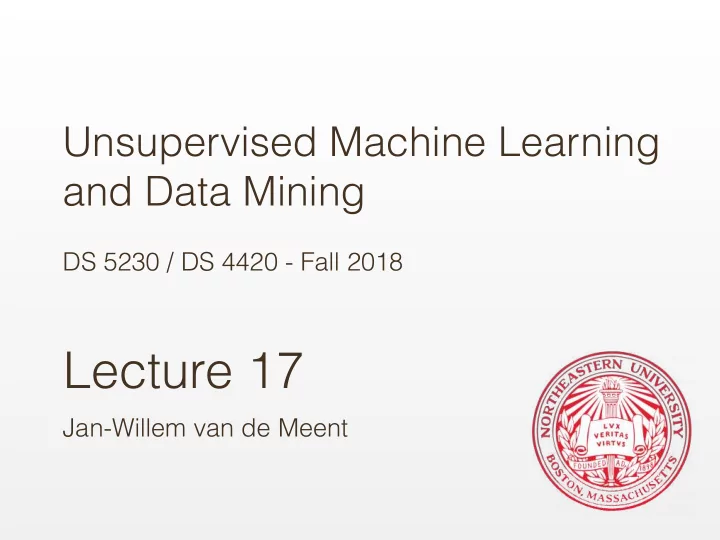

Unsupervised Machine Learning and Data Mining DS 5230 / DS 4420 - Fall 2018 Lecture 17 Jan-Willem van de Meent
Community Detection Problem: Can we identify groups of densely connected nodes? (Adapted from: Mining of Massive Datasets, http://www.mmds.org)
Communities: Football Conferences Nodes: Football Teams, Edges: Matches, Communities: Conferences (Adapted from: Mining of Massive Datasets, http://www.mmds.org)
Communities: Academic Citations Source: Citation networks and Maps of science [Börner et al., 2012] Nodes: Journals, Edges: Citations, Communities: Academic Disciplines (Adapted from: Mining of Massive Datasets, http://www.mmds.org)
Communities: Protein-Protein Interactions Nodes: Proteins, Edges: Physical interactions, Communities: Functional Modules (Adapted from: Mining of Massive Datasets, http://www.mmds.org)
Community Detection Graph Partitioning Overlapping Communities We will work with undirected (unweighted) networks (Adapted from: Mining of Massive Datasets, http://www.mmds.org)
Centrality Measures HIGHEST 6 7 17 BETWEENNESS 16 15 CENTRALITY 8 9 1 2 3 4 5 14 10 11 HIGHEST 13 HI HEST DEGREE G S G 12 CLOSENESS CENTRALITY CENTRALITY (a) centrality illustration • Betweenness : Number of shortest paths • Closeness : Average distance to other nodes • Degree : Number of connections to other nodes
Betweenness Edge Strength (call volume) Edge Betweenness • Betweenness : Number of shortest paths passing through a node or edge (Adapted from: Mining of Massive Datasets, http://www.mmds.org)
Edge Betweenness 5 12 4.5 A B D E 1 5 4 4.5 1.5 C G F 1.5 • Count number of shortest paths passing through each edge ( can be done with weighted edges ) • If there are multiple paths of equal length, then split counts
Girvan-Newman Algorithm (hierarchical divisive clustering according to betweenness) 12 1 33 49 Repeat until k clusters found 1. Calculate betweenness 2. Remove edge(s) with highest betweenness (Adapted from: Mining of Massive Datasets, http://www.mmds.org)
Girvan-Newman Algorithm (hierarchical divisive clustering according to betweenness) Step Step Hierarchical network Step (Adapted from: Mining of Massive Datasets, http://www.mmds.org)
Girvan-Newman: Physics Citations (Adapted from: Mining of Massive Datasets, http://www.mmds.org)
Girvan-Newman Two problems 1. How can we compute the betweenness for all edges? 2. How can we choose the number of components k? (Adapted from: Mining of Massive Datasets, http://www.mmds.org)
Calculating Betweenness How can we count all shortest paths? • Loop over nodes in graph • Perform breadth-first search to find shortest paths to other nodes • Increment counts for edges traversed by shorts paths • Divide final betweenness by 2 ( since all paths counted twice )
Counting Shortest Paths 1 E E 4.5 1.5 1 1 4.5 D F 1.5 D F 3 0.5 0.5 1 3 2 B G B G 1 1 1 1 1 1 A C 1 A C Count number of Accumulate credit shortest paths from upwards, dividing (E) to each node across shortest paths (Adapted from: Mining of Massive Datasets, http://www.mmds.org)
Counting Paths: Larger Example Original Graph Breadth-first Ordering from A (Adapted from: Mining of Massive Datasets, http://www.mmds.org)
Counting Paths: Larger Example Step 1. Count number of shortest paths from to each node (Adapted from: Mining of Massive Datasets, http://www.mmds.org)
Counting Paths: Larger Example 1 path to K. Split in ratio 3:3 Step 2. Propagate credit upwards, splitting according to number of paths to parents (Adapted from: Mining of Massive Datasets, http://www.mmds.org)
Counting Paths: Larger Example 1+0.5 paths to J Split 1:2 1 path to K. Split in ratio 3:3 Step 2. Propagate credit upwards, splitting according to number of paths to parents (Adapted from: Mining of Massive Datasets, http://www.mmds.org)
Counting Paths: Larger Example 1+0.5 paths to J Split 1:2 1 path to K. Split in ratio 3:3 Step 2. Propagate credit upwards, splitting according to number of paths to parents (Adapted from: Mining of Massive Datasets, http://www.mmds.org)
Counting Paths: Larger Example 1+0.5 paths to J Split 1:2 1 path to K. Split in ratio 3:3 Step 2. Propagate credit upwards, splitting according to number of paths to parents (Adapted from: Mining of Massive Datasets, http://www.mmds.org)
Counting Paths: Larger Example 1+0.5 paths to J Split 1:2 1 path to K. Split in ratio 3:3 Step 2. Propagate credit upwards, splitting according to number of paths to parents (Adapted from: Mining of Massive Datasets, http://www.mmds.org)
Determining the Number of Communities Hierarchical decomposition Choosing a cut-off Analogous problem to deciding on number of clusters in hierarchical clustering (Adapted from: Mining of Massive Datasets, http://www.mmds.org)
Modularity Idea: Compare fraction of edges within module to fraction that would be observed for random connections Adjacency Matrix Node Degree Node Assignment (Adapted from: Mining of Massive Datasets, http://www.mmds.org)
Modularity Use modularity to optimize connectivity within modules (Adapted from: Mining of Massive Datasets, http://www.mmds.org)
Recommend
More recommend